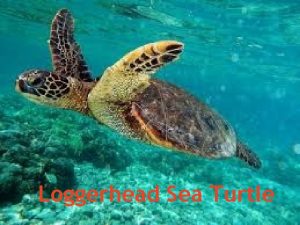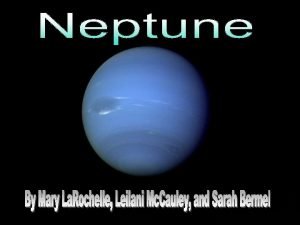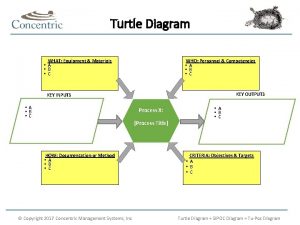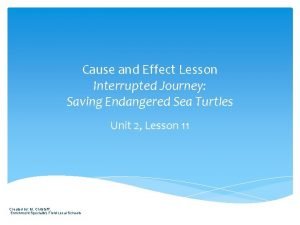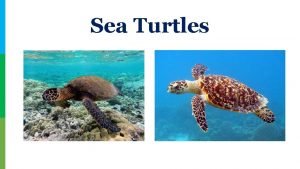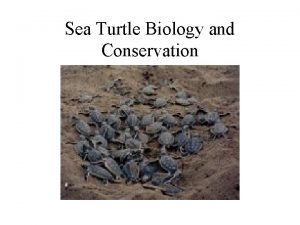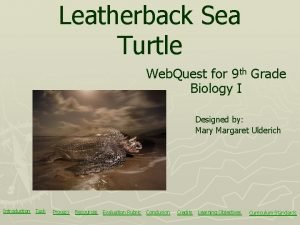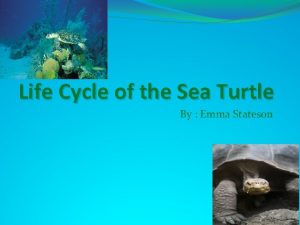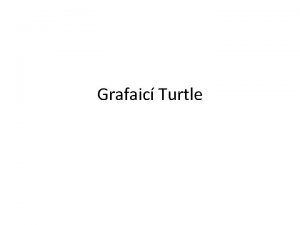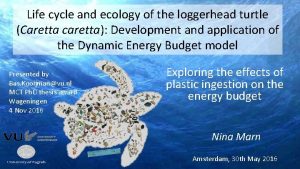Loggerhead Sea Turtle Loggerhead Sea Turtle were named












- Slides: 12

Loggerhead Sea Turtle

Loggerhead Sea Turtle were named for their relatively large block like heads. They are perhaps the most familiar Type of sea turtle. The loggerhead Sea turtle is also the only one that still nets frequently on the U. S. Atlantic coast, on the beaches from new Jersey to Texas. (Department of environmental conservation)

The loggerhead Sea Turtle is It is identifiable with a known as the Caretta typical average pf three Caretta scientifically. feet (. 9 m) length. It weighs in at a very large three hundred pounds in kilograms that is one hundred and thirty six kg. The Loggerhead Sea Turtle are reddish/orange in colour, their shell is heart shaped. Their shell has five pairs of lateral scutes, five central scutes, 4 prefrontal scutes and three Inframarginal scutes. The picture on the right shows what a scute is. -> (DEC)

The diet of the Loggerhead Turtle is very vast thanks to its very powerful set of jaws. they are well matched for eating hard shelled prey such as crabs, other crustaceans , clams, sea urchins, mollusks, jellyfish, sometimes and eelgrass ( a special type of seaweed). They are less likely to be hunted for their meat or shell compared to other sea turtle. (DEC, World Wild Life)

The majority of the nesting happens north of the gulf of Mexico and the Caribbean Sea in temperate waters, in spite of the fact that some individuals nest in the western Caribbean. The turtles also nest along the south eastern U. S. coast with ninety percent of nests occurring in Florida. The female loggerhead turtles come out of the water to lay their eggs on the beaches at night. One turtle may nest up to seven times a season, laying between one hundred and twenty five eggs every fourteen plus days. The map shows the majority of nesting grounds for the loggerhead sea turtles. (DEC)

The eggs hatch in roughly fifty-five to sixty-five days; the hatchlings appear at night to spend their first year surrounded by mats of sargassum (type of algae / seaweed) and other flotsam (debris that was not purposely thrown over board). Sexually maturity is accomplished around the ten to fifteen year mark and the estimated maximum life expectancy is thirty years. (DEC)

The loggerhead turtle are very vast when it comes to distribution in fact they are found globally. They are partial to temperate and sub tropical waters. In the western Atlantic, they vary from the Canadian maritime provinces south to Argentina. With in the collection, this species lives in warm waters on continental shelves and areas among islands. Estuaries, coastal streams and salt marshes are more common habitats.

Loggerhead turtles The human population is also a threat. In Florida and their eggs are Almost the entire Coastline is developed, under development, or being hunted to a subject to development. The introduction of exotic vegetation large extent in many by humans. part of the world. which may form dense root mats along shores, inhibiting egg. However in the U. S. laying and trapping hatchlings. Beds of sargassum weed where the main threat the early part of the life cycle is spent, accumulate pollutants comes from raccoons such as oils, Styrofoam and other plastics. and wild boars which eat the eggs. On some of the nesting beaches, raccoons have been known to possibly destroy more then ninety five percent of the nests.

Since 1978, the endangered species act has banned commercial exploitation of loggerhead sea turtles in the U. S. Exploitation still occurs in other places around the world. In order to help turtles that may become stuck during migrations in the summer months, a stranding network was created in 1980 through the cooperation of the new York of environmental conservation, national marine fisheries service and the riverhead foundation. Through this system, the Riverhead Foundation is informed of strandings through a telephone number. Marine biologists there handle stuck turtles and dead specimens to collect biological information. (DEC)

In response to sea turtle mortality in trawl nets, the U. S. Fisheries and wildlife services have provided regulations, requiring prawn trawlers of the south eastern and gulf coasts to have a turtle excluder device (TED) on their nets. This device allows turtles and other large marine life to escape should they enter a net.

In conclusion, the loggerhead sea turtles are large omnivores that have a block like head. They are widely spread across the world. The loggerhead is most probably the most familiar turtle yet it has many threats that endanger their survival. On the other hand, many organisations and services are attempting to protect them by using special device such as the TED which allows turtles and other large marine life to escape nets. The loggerhead turtle are endangered but can still be identified by their reddish-brown colour and heart shaped shell if you take the time to try and spot them.

I researched and gathered the majority of my information from http: //www. dec. ny. gov/animals/7156. html I also collected some of the information from the following siteswww. nmfs. noaa. gov Loggerhead turtle ( caretta): : No. AA Fisheries And the last website is https: // www. worldwildlife. org loggerhead turtle/sea turtles/species ) WWF
 Habitat of sea turtle
Habitat of sea turtle Is there water on neptune
Is there water on neptune Sea turtle diagram
Sea turtle diagram Sea turtle cause and effect
Sea turtle cause and effect Hawksbill sea turtle size
Hawksbill sea turtle size Largest turtle ever
Largest turtle ever Sea turtle conservation webquest answer key
Sea turtle conservation webquest answer key Life cycle of a hawksbill sea turtle
Life cycle of a hawksbill sea turtle Acrostic poem on ocean
Acrostic poem on ocean Future in the past continuous
Future in the past continuous What does the sea symbolize in the old man and the sea
What does the sea symbolize in the old man and the sea Led soldiers across hellespont into anatolia
Led soldiers across hellespont into anatolia Sea stack sea arch
Sea stack sea arch
